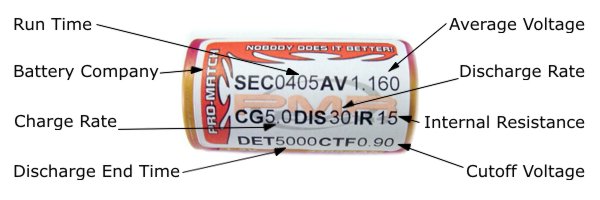|
What makes
matched cells so special?
When the cells are delivered to the
matching company, like Pro-Match Racing, they are "matched" (a process by
which they are charged and discharged "cycled") Cycling measures the
performance parameters of each cell. For information on performance
parameters see our page on
battery labels. The
cells are then grouped into categories like world spec, sport, team, xtreme
, factory team. The cells with the lowest numbers go into the spec, sport,
or stick packs. The higher numbers go into the team, xtreme, or factory
team packs.
This
information was taken from the Pro-Match racing site which I helped design
in April of 2003. I also designed the label that Pro-Match currently
uses on all of their matched batteries.

Run time - Amount of time it
takes to discharge the cell to the discharge cutoff voltage. Run time
is important, as it tells you how long the cell will last when discharged
at the discharge current to the discharge cutoff voltage. Run time
is most important to people who drive modified on oval tracks. Divide this
number by 60 to figure out about how many minutes the pack will last under race
condition. NOTE: Make sure when comparing cells that they have the same
discharge rate. The Run Time on a pack discharged at 30 amps will be lower that
the Run Time on a pack discharged at 20 amps. See the Pro-Match Racing
conversion chart for more details.
Charge rate - Amperage rate the cell is
charged at. The charge rate is a determining factor in the internal
resistance reading . The higher the amperage the cell is charged at the higher
the relative internal resistance number will be on the label.
Discharge rate - Amperage load used to
discharge the cell. The discharge cutoff voltage standards are .85-.90
volts for 30 amp and .90 for 20 and 25 amp cells. This is the voltage at which
the discharge process ends. Lowering this cutoff point will extend run time
results and lower the average voltage reading. Raising this point will shorten
run time but raise the average voltage reading.
Discharge cutoff voltage -
Voltage level used to stop the voltage averaging.
Average voltage - The average voltage
level throughout the discharge process. The average voltage is
calculated by sampling the voltage 10 times per second, starting at the peak
voltage and terminating the sampling when either the discharge cutoff
voltage is reached, or when the discharge time has expired. It is
possible to 'fudge' the average voltage by setting the **discharge cutoff
time to be lower than the time it takes the cell to discharge to the
cutoff voltage. For example... if a cell takes 250 seconds to discharge to
.90 volts (the cutoff voltage) then it is safe to assume that as long
as the discharge cutoff time is set to be at least 250 seconds, the
average voltage calculation will be correct. But what happens if the
discharge cutoff time is set to 200 seconds? Well, the answer is simple... the
average voltage will be calculated only for the first 200 seconds of
the discharge, resulting in an average voltage much higher than it would be if
calculated for the full discharge. Pro-Match always sets the discharge time
to 5000 seconds, so that the average voltage calculation will always be
correct! Beware of matchers that change this value or do not print this number
on their labels at all! The higher the average voltage, the faster top speed
your motor will have. Average voltage is most important to people who
race in stock oval classes.
Internal resistance - The resistance of
the cell's internal structure. A cell's internal resistance is a
key factor in the amount of 'punch' it can provide. The lower
the internal resistance, the quicker the energy can be released from a
cell, giving you more "bottom end" power. This number is most important in
off-road, touring car, and small tight oval tracks where fastest acceleration is
needed.
Discharge cutoff time - Number of seconds
before terminating the average voltage calculation. Make sure this number is on
the cell and set to 5000 (default setting)
Team Orion also has a great battery question page that can be found here.
Team Orion Battery FAQ |